Shipyard Employment eTool
Access and Guarding of Work Surfaces >> Access to Vessels

Workers must board vessels in drydock, in the water, or from adjacent vessels. Proper access while boarding is critical because many fatalities have occurred from workers falling into the water or on the surfaces below.
The following discusses access to:
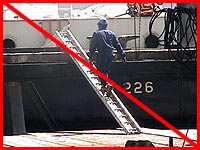
Personnel must board vessels safely using approved boarding devices. Movement of the floating vessel can cause movement of the boarding device, thus increasing the possibility of workers falling or being injured by a moving device.
Potential Hazards
- Workers being injured when boarding a vessel
- Workers falling off the gangways or ladders to a lower level or into the water
- Structural failure of a gangway or ladder causing the worker to fall to a lower level or into the water
- Movement of the gangway or ladder resulting in injuries
- Workers being struck by moving material or cargo loads
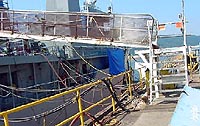
Requirements and Example Solutions
The employer shall not permit employees to board or leave any vessel, except a barge or river towboat, until the following requirements have been met:
- An adequate gangway must be provided. When a gangway is not practical, then an straight ladder or Jacob's ladder must be used. [29 CFR 1915.74(a)(1)]
- Gangway must maintain clear access, have at least 33-inch-high hand rails, be properly trimmed, and be properly illuminated. [29 CFR 1915.74(a)(2), (a)(4), (a)(5), (a)(8), (a)(10) and (a)(11)]
- When the end of the gangways overhangs the water, it must be bridged and a net must be present. [29 CFR 1915.74(a)(6) and (a)(7)]
- When the upper end of the gangway or ladder rests on or is flush with the top of the bulwark or hand rail, steps with adequate guardrails are required. [29 CFR 1915.74(a)(9)]
- Suspended loads must not pass over the gangway. [29 CFR 1915.74(a)(12)]
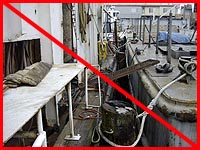
Potential Hazards
- Workers falling during the boarding of a vessel due to inadequate gangways or ladders
- Structural failure of the gangway or ladder causing workers to fall
- Movement such as surging of the gangway or ladder that results in injuries
Requirements and Example Solutions
- Adequate gangways must be provided for access from vessel to drydock or from vessel to vessel. [29 CFR 1915.74(b)]
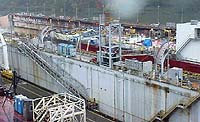
Potential Hazards
- Workers falling from gangways or ladders while boarding barges and river towboats because of the movement of the vessels.
- Structural failure of the gangway or ladder causing workers to fall.
- Surging of the vessel causing pinching between the gangway or ladder, and the vessel.
Requirements and Example Solutions
- Ramps for access of vehicles onto or between barges shall be of adequate strength, provided with side boards, be well-maintained and properly secured. [29 CFR 1915.74(c)(1)]
- Unless employees can step safely to the vessel, a gangway or ladder is required. [29 CFR 1915.74(c)(2)]
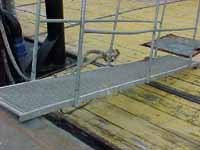
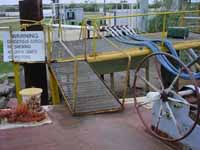

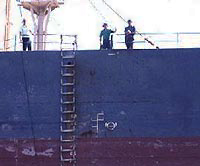
A Jacob's ladder is a marine ladder made of rope or chain with wooden or metal rungs. When conditions are such that neither a gangway nor a straight ladder can be used to board a vessel, a Jacob's ladder may be used.
Potential Hazards
- Workers falling from ladders when boarding barges and river towboats because of the movement of the vessel or ladder
- Structural failure of the ladder causing workers to fall
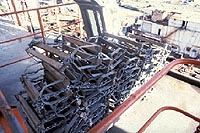
Requirements and Example Solutions
- Jacob's ladders must be of the double-rung or flat-tread type and be well-maintained and properly secured. [29 CFR 1915.74(d)(1)]
- A Jacob's ladder must either hang without slack from its lashings or be pulled up entirely. [29 CFR 1915.74(d)(2)]

